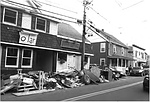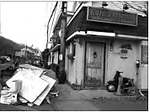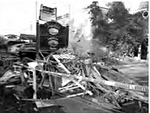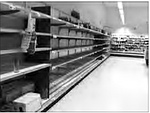Why New York City Should Pay Attention to Piermont, NY
Like New York City, the tiny Hudson River town of Piermont, NY was built at water’s edge because of commerce. Ships, and later, trains, pumped goods in and out of ports vital to economic survival. But with sea levels conservatively estimated to rise seven to twenty-three inches by 2100 according to a 2007 NY State study, and storm surges becoming increasingly severe, waterside communities, big and small, are rethinking their infrastructure.
Piermont, a community familiar with flooding of the tidal marsh at its southern edge, but not accustomed to water engulfing its Main Street as happened with Sandy, is perhaps a microcosm of the challenges facing the Zone A areas of New York City. Many of Piermont’s businesses and restaurants occupy bottom levels of 19th century buildings. Some are just a few feet above sea level and only a baseball field’s width from the river’s edge. Even so, they are not in designated flood zones and flooding from the river is rare. But 14 months ago, Hurricane Irene brought river water swirling into town, and two weeks after Sandy, almost a third of Piermont’s businesses remain closed because of salt water damage to electrical wiring, HVAC systems and other equipment submerged during the storm.
“We didn’t think it would come this far,” said Lynn Aubrey, owner of Aubrey Flowers, a small shop on the side of Main Street farthest from the river. She was busy repainting the store’s interior after scrubbing the space clean of sewage damage. Aubrey expects to reopen soon, but estimates her losses will be anywhere between $20,000 and $30,000.
"Anyone with a basement got hit,” said George Demarsico, the chef at Freelance Café & Wine Bar. The restaurant’s basement wine cellar was inundated with six feet of water, but with the entire staff cleaning round the clock and some luck getting contractors lined up, Freelance hopes to reopen by next week.
A handful of Piermont’s businesses won’t bounce back so quickly. Those fronting the T & R Marina suffered not just flooding, but structural damage when unmoored boats turned into battering rams during the storm. Many boats were destroyed and some buildings may be unsalvageable. So if Piermont is to protect its business district from the ravages of future storms it appears the town will need to be proactive. When asked if raising seawalls is a possibility, Piermont’s Mayor, Chris Sanders, said, “We’re in early exploration with the Army Corps of Engineers to see what they can do to help us out regarding seawalls.” But the village is moving ahead with smaller steps. Charles Schaub, Piermont’s Building Inspector, is urging business owners to move their electric meters above Sandy’s flood line. He suggests the level be marked on telephone poles for residents and business owners to use as a guide. He’s also recommending that, if at all possible, businesses should move water heaters, HVAC systems, and any other equipment out of basements.
Also, flood plain designations continually updated by FEMA may require more business owners to carry flood insurance. According to the NY State Dept. of Financial Services, a flood insurance policy for a business will cover up to $500,000 on a non-residential building and its contents.
As for structures that have already experienced repeated flooding, Mayor Sanders said, “We may need to look at modifying zoning restrictions and allow certain elevations of buildings to take place.” But perhaps the biggest adjustment for the village is the acceptance that that once-in-decade storm may now be an annual event.
“We need to be prepared in the village to be on our own,” said Sanders, “because when a major storm like this hits, if it’s enough to inundate the village, its got a lot of damage down river and there’s far more people in a lot more trouble.” Sanders has that right. While Piermont has roughly 2,500 residents, New York City’s Zone A is home to about 250,000. And if sea levels rise one to two feet in the next 80 years as predicted, Zone A just gets bigger. For more and more people, living and working in a flood zone will be the norm.
That day has already come in Piermont.







